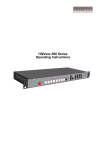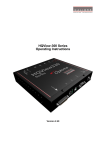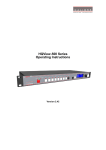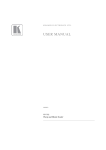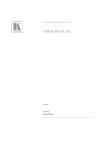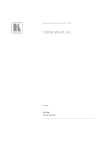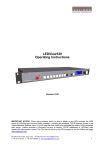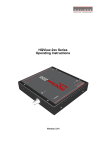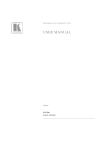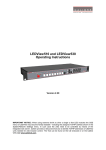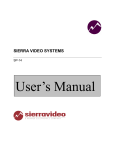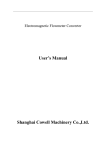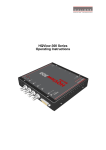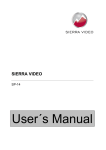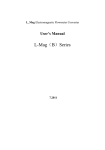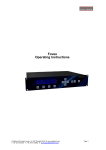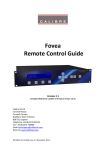Download ICADLL/95 Manual
Transcript
HQView-325 Operating Instructions Version 2.43 This manual explains how to operate your HQView-325 image scaler. HQView-325 is designed to provide users with a powerful and flexible method of driving large display devices, and multiple screen applications including flexible geometry correction functions. If you have any queries relating to this or any other product supplied by Calibre please visit our web site www.calibreuk.com. For technical support please e-mail [email protected] or send your queries by fax to (44) 1274 730960, for the attention of our Technical Support Department. COPYRIGHT This document and the software described within it are copyrighted with all rights reserved. Under copyright laws, neither the documentation nor the software may be copied, photocopied, reproduced, translated, or reduced to electronic medium or machine readable form, in whole or in part, without prior written consent of Calibre UK Ltd ("Calibre"). Failure to comply with this condition may result in prosecution. Calibre does not warrant that this product package will function properly in every hardware/software environment. Although Calibre has tested the hardware, firmware, software and reviewed the documentation, CALIBRE MAKES NO WARRANTY OR REPRESENTATION, EITHER EXPRESS OR IMPLIED, WITH RESPECT TO THIS HARDWARE, FIRMWARE, SOFTWARE OR DOCUMENTATION, THEIR QUALITY, PERFORMANCE, MERCHANTABILITY, OR FITNESS FOR A PARTICULAR PURPOSE. THIS SOFTWARE AND DOCUMENTATION ARE LICENSED 'AS IS', AND YOU, THE LICENSEE, BY MAKING USE THEREOF, ARE ASSUMING THE ENTIRE RISK AS TO THEIR QUALITY AND PERFORMANCE. IN NO EVENT WILL CALIBRE BE LIABLE FOR DIRECT, INDIRECT, SPECIAL, INCIDENTAL, OR CONSEQUENTIAL DAMAGES ARISING OUT OF THE USE OR INABILITY TO USE THE SOFTWARE OR DOCUMENTATION, even if advised of the possibility of such damages. In particular, and without prejudice to the generality of the foregoing, Calibre has no liability for any programs or data stored or used with Calibre software, including costs of recovering such programs or data. Calibre UK Ltd Cornwall House, Cornwall Terrace Bradford, West Yorkshire BD8 7JS, England Telephone Fax Email Web-site Copyright +44 (0)1274 394125 + 44 (0)1274 730960 [email protected] www.calibreuk.com (c) 2015 All World-wide Rights Reserved All trade marks acknowledged Calibre operates a policy of continued product improvement, therefore specifications are subject to change without notice as products are updated or revised. E&OE. 24th June 2015, W: www.calibreuk.com T:+44 1274 394125 F: +44 1274 730960 E: [email protected] © Calibre UK Limited Issue 2.43 Contents SAFETY WARNING: INTRODUCTION 1.1. General Introduction HQVIEW-325 SYSTEM DESCRIPTION 2.1. Product Overview 2.2. Product Specification 2.2.1. Power Supply Requirement 2.2.2. Computer (SVGA) Inputs VESA formats 2.2.3. HDMI & DVI Inputs 2.2.4. Audio Output 2.2.5. Display Output HQVIEW-325 CONTROL 3.1. Menu Tree 3.2. Introduction 3.3. Main Menu 3.4. Input 3.5. Output 3.5.1. Display Type 3.5.2. Output Mode 3.5.3. Location 3.5.4. Frame Rate 3.5.5. I/O Lock 3.5.6. Native Colour Temp 3.5.7. Output Gamma 3.5.8. Output Config 3.6. Colour 3.6.1. Black-Level Offset 3.6.2. Black-Level 3.6.3. Contrast 3.6.4. Saturation 3.6.5. Hue 3.6.6. RGB values 3.6.7. Colour Temp 3.6.8. Input Gamma 3.7. Geometry 3.7.1. Horizontal/Vertical Position 3.7.2. Edge Control 3.7.3. Picture Format 3.7.4. Overscan 3.7.5. Pan Tilt Zoom 3.7.6. Warp 3.8. Multiple Unit 3.8.1. Auto Zoom 3.8.2. Units Wide/Units High 3.8.3. Horizontal Pos/Vertical Pos 3.8.4. Blend Width 3.8.5. Blend Curve Type 3.8.6. Black-Level Uplift 3.8.7. Reduce Black-Level Uplift Width 3.9. Enhancement 3.9.1. Sharpness 3.9.2. Detail 3.9.3. Video Filters 3.10. System 3.10.1. User 3.10.2. Names/Profiles 3.10.3. Input Config 3.10.4. Display Mode 24th June 2015, W: www.calibreuk.com T:+44 1274 394125 F: +44 1274 730960 E: [email protected] © Calibre UK Limited Issue 2.43 1 2 2 4 4 4 4 4 4 4 5 7 7 13 14 14 14 14 15 15 15 15 16 16 16 18 18 18 18 18 18 18 18 18 19 19 19 19 19 20 20 21 21 21 21 21 22 22 22 23 23 23 23 23 23 23 24 25 3.10.5. Menu Settings 3.10.6. Network Settings 3.10.7. Factory Defaults REMOTE CONTROL WEB SERVER 4.1. Introduction 4.2. Installing the Software 4.3. Discovery Tool 4.4. Software Operation 4.5. File Upload FIRMWARE UPDATE 5.1. Introduction 5.2. Updating Firmware ENVIRONMENTAL AND EMC 6.1. Recommended Operating Conditions 6.2. Storage 6.3. CE and FCC Compliance 6.4. PAT Testing 24th June 2015, W: www.calibreuk.com T:+44 1274 394125 F: +44 1274 730960 E: [email protected] © Calibre UK Limited Issue 2.43 25 25 25 26 26 26 26 26 27 29 29 29 30 30 30 30 30 SAFETY WARNING: 1. THERE ARE NO USER SERVICEABLE PARTS WITHIN THE UNIT. REMOVAL OF THE TOP COVER WILL EXPOSE DANGEROUS VOLTAGES. DO NOT OPERATE THE UNIT WITHOUT THE TOP COVER INSTALLED. 2. ENSURE THAT ALL ELECTRICAL CONNECTIONS (INCLUDING THE MAINS PLUG AND ANY EXTENSION LEADS) ARE PROPERLY MADE AND COMPLY WITH ELECTRICAL SAFETY REGULATIONS. 3. ENSURE THAT THE INTEGRITY OF THE EQUIPMENT ISOLATION BARRIER IS MAINTAINED WHEN CONNECTING TO OTHER EQUIPMENT. THIS MEANS THAT ONLY LOW VOLTAGE ISOLATED CIRCUITS MAY BE CONNECTED TO THE SIGNAL INPUTS AND OUTPUTS. IF ANY DOUBT EXISTS CONSULT QUALIFIED SERVICE PERSONNEL. 4. TO PREVENT SHOCK OR FIRE HAZARD DO NOT EXPOSE THIS EQUIPMENT TO RAIN OR MOISTURE. IF SUCH EXPOSURE OCCURS, REMOVE THE PLUG FROM THE MAINS OUTLET AND HAVE THE EXPOSED UNIT CHECKED BY QUALIFIED SERVICE PERSONNEL. 5. DO NOT CONTINUE TO OPERATE THE EQUIPMENT IF YOU HAVE ANY DOUBT ABOUT IT WORKING NORMALLY, OR IF IT IS DAMAGED IN ANY WAY. WITHDRAW THE MAINS PLUG FROM THE MAINS OUTLET AND CONSULT QUALIFIED SERVICE PERSONNEL. 6. DO NOT REMOVE ANY FIXED COVERS UNLESS YOU ARE QUALIFIED TO DO SO AND EVEN THEN WITHDRAW THE MAINS PLUG FROM THE MAINS OUTLET BEFORE YOU START. 7. THIS EQUIPMENT CONTAINS NO USER SERVICEABLE PARTS. MAINTENANCE TO QUALIFIED SERVICE PERSONNEL. 8. TO AVOID EXPLOSION, DO NOT OPERATE THIS EQUIPMENT IN AN EXPLOSIVE ATMOSPHERE REFER ALL SERVICING AND © Calibre UK Limited Issue 2.43 24th June 2015, W: www.calibreuk.com T:+44 1274 394125 F: +44 1274 730960 E: [email protected] 1 INTRODUCTION 1.1. General Introduction HQView-325 is a very flexible image scaler developed specifically for driving large screen displays and multiple screen applications from video or graphics sources. HQView-325 features state of the art digital image processor which provides market leading HD & SD per-pixel multiple Iow-angle motion-adaptive de-interlacing and automatic film pull-down correction for 3:2 and 2:2, significantly outperforming the capabilities of benchmark competitor products. HQView-325 features excellent image processing algorithms for the very best scaling, film and video noise reduction and MPEG artefact reduction. HQView-325 uses a flexible high performance video input front end including HDMI and DVI video with HDCP encryption, as well as computer graphics inputs in SVGA analogue and HDMI/DVI digital formats. The output format can be set to I/O Lock mode where it locks the output frame rate to the input frame rate dynamically without frame rate conversion so as to reduce system latency, or it can be set to a fixed output frame rate for driving basic screens which are not 50Hz-compatible. A Low latency mode with non-motion adaptive reduced processing is available for when the shortest latency is important. Outputs are available in DVI/HDMI digital formats with HDCP encryption compatibility. HQView-325 supports Pan, Tilt and Zoom to select a part of the input image, fill the screen and pan within it. HQView-325 supports multi-screen or multi-projector installations by means of Auto Zoom and Edge Blend with elaborate Black Level Uplift. Edge Blend electronically reduces the brightness level of certain image regions to seamlessly match the brightness of overlapping areas. Auto Zoom automatically crops and zooms the input video image to display a section of the total image on the corresponding projector or screen. Embedded warp allows adjustment of the image in a projection scenario to match a rotated, tilted or curved screen. For 9:16 portrait mode signage special predefined portrait modes are available to rotate and stretch a video image to fill a +/-90° rotated display panel. HQView-325 also features free form warp capability for non-flat screens in single or multi projector installation. Warp maps created with the PC tool “Warp Generator” can be uploaded into HQView-325. rd HQView-325 is supported by 3 party PC based auto calibration software creating such warp maps using camera captured information. System control is via an OSD controlled by keys on the front panel or through the inbuilt TCP/IP web server. Additionally a free API manual is published on our website at the link given below to allow the use of the LAN or RS232 remote control ports. http://www.calibreuk.com/documents/led/HQView_LEDView%20API%20Protocol_v3.04%20Generic.pdf © Calibre UK Limited Issue 2.43 24th June 2015, W: www.calibreuk.com T:+44 1274 394125 F: +44 1274 730960 E: [email protected] 2 1.1.1. Packing List HQView-325 is supplied with the following: 1) This manual 2) 3 pin plug IEC mains cable 3) DVI-D output cable 4) CD containing manuals and useful applications © Calibre UK Limited Issue 2.43 24th June 2015, W: www.calibreuk.com T:+44 1274 394125 F: +44 1274 730960 E: [email protected] 3 HQVIEW-325 SYSTEM DESCRIPTION 2.1. Product Overview HQView-325 is designed to accept the following input signals: VGA analogue (computer interface) via a 15HDD nd DVI (Digital Visual Interface) via DVI-I (supporting a digital or 2 analogue VGA input) HDMI via HDMI connector 2.2. Product Specification This section provides technical details for all possible inputs. Please note that not all possible input options may be applicable to certain output modes. 2.2.1. Power Supply Requirement 100V-264VAC 50/60Hz connected via a standard IEC connector located on the rear panel. 2.2.2. Computer (SVGA) Inputs VESA formats Signal formats: RGB video level RGB input impedance Sync format 2.2.3. DOS, VGA – WUXGA up to 165MHz pixel clock 0.7V - 1.0V 75 Ohms Separate H & V sync at TTL/5V levels. HDMI & DVI Inputs HDMI 1.3 with or without HDCP, 36-bit video deep colour compatible. HDCP compatibility can be turned off for use with MAC computers. DVI-D input with or without HDCP Signal formats -video 480i and 576i (SD) in double-rate formats (1440 pixels per line), 480p, 576p (ED), 720p, 1080i at 50, 59.94 & 60Hz, 1080p at 24, 25, 30, 50, 59.94 & 60Hz. Signal formats – computer DOS, VGA – WUXGA up to 165 MHz pixel clock 2.2.4. Audio Output Audio is embedded in the HDMI input video stream. The audio is passed through the system and reembedded into the HDMI output signal. Also, HQView-325 features a S/PDIF coaxial digital audio output connector for monitoring audio of the HDMI channel. When HDMI is selected as the input channel the HDMI EDID is read by a video source such as a Blue Ray Player. HQView-325 allows the source to provide the formats shown under output formats for HDMI in the below table. (Note: Dolby TrueHD and DTS HD-Master are not in the list of audio formats and thus not supported.) © Calibre UK Limited Issue 2.43 24th June 2015, W: www.calibreuk.com T:+44 1274 394125 F: +44 1274 730960 E: [email protected] 4 All formats are re-embedded into the HDMI output data stream, those which are not allowed on the SPDIF output are muted on the SPDIF channel. Output Channel HDMI SPDIF 2.2.5. Output Format PCM up to 8ch, up to 24Bit, up to 192kHz sampling rate (incl. 32kHz,44.1kHz,48kHz,96kHz,192kHz) Dolby Digital (AC3) up to 5.1 channels, up to 640kBit/sec bit stream rate MPEG2 up to 8ch, up to 112kBit/sec bit stream rate DTS up to 6.1 channels, up to 1536kBit/sec bit stream rate PCM up to 2ch, up to 24Bit, up to 96kHz sampling rate (incl. 32kHz,44.1kHz,48kHz,96kHz) Dolby Digital (AC3) up to 5.1 channels DTS up to 6.1 channels Display Output A DVI-I connector is provided which will support DVI outputs as well as HDMI 1.3 with 36-bit video and HD audio formats when connected to a suitable HDMI 1.3 receiver. When the input signal has HDCP encryption, the DVI-D output connector will carry a similarly HDCP encrypted signal. When an HDCP encrypted signal is input, but the display device does not support HDCP, the output image will turn black and a message indicating HDCP Signal will come up to indicate this. The color depth of the HDMI output signal is determined by the set-up of HQView and the capabilities of the monitor. The bit depth per color channel is displayed in the output section of the menu system Note: The processor’s HDCP compliance can be turned off. This is of importance particularly when using a MAC computer as the source. A MAC will encrypt it’s output signal if a compliant device is seen attached to it’s output. By turning off the HQView processor’s compliance the MAC will see a noncompliant device and therefore will not encrypt its output. © Calibre UK Limited Issue 2.43 24th June 2015, W: www.calibreuk.com T:+44 1274 394125 F: +44 1274 730960 E: [email protected] 5 The following output modes can be set up: (HFP/VFP: horizontal/vertical front porch, HBP/VBP: horizontal/vertical horizontal/vertical sync, HTot/VTot: horizontal/vertical total pixels) HTot HFP HS HBP VTot VFP VS VBP front porch, HS/VS: Hor Pix Ver Pix Hor Freq Ver Freq Pix Clock 640 480 800 16 96 48 525 10 2 33 31.47 59.94 25.175 Specification VESA DMT 640 640 480 480 800 800 16 16 96 96 48 48 629 629 62 62 2 2 85 85 31.46 30.19 50.02 48.00 25.170 24.154 proprietary proprietary 800 800 600 600 1056 1056 40 40 128 128 88 88 628 628 1 1 4 4 23 23 37.88 31.40 60.31 50.00 40.000 33.158 VESA DMT VESA 60 - CLK wind down 800 1024 1024 600 768 768 1056 1344 1312 40 24 40 128 136 104 88 160 144 628 806 793 1 3 3 4 6 4 23 29 18 30.14 48.36 39.63 48.00 60.00 49.98 31.832 65.000 52.000 proprietary VESA DMT VESA CVT 001M3 1024 768 1312 40 104 144 793 3 4 18 38.11 48.06 50.000 proprietary 1280 768 1664 64 128 192 798 3 7 20 47.78 59.87 79.500 VESA CVT 001M9/VESA DMT 1280 1280 768 768 1648 1648 56 56 128 128 184 184 793 793 3 3 7 7 15 15 39.59 38.06 49.93 48.00 65.250 62.730 VESA CVT001M9 proprietary 1280 1280 1280 800 800 800 1680 1680 1680 72 72 72 128 128 128 200 200 200 831 831 831 3 3 3 6 6 6 22 22 22 49.70 41.55 39.89 59.81 50.00 48.00 83.500 69.804 67.012 VESA CVT 001MA/VESA DMT propietary propietary 1280 1280 1024 1024 1688 1688 48 48 112 112 248 248 1066 1066 1 1 3 3 38 38 63.98 53.32 60.02 50.02 108.000 90.000 VESA DMT VESA 60 - CLK wind down 1280 1360 1360 1024 768 768 1688 1792 1744 48 64 56 112 112 136 248 256 192 1066 795 793 1 3 3 3 6 5 38 18 17 51.17 47.71 39.56 48.00 60.02 49.89 86.370 85.500 69.000 proprietary VESA AddDMT VESA CVT 001M9 1360 1366 1366 1400 1400 768 768 768 1050 1050 1688 1792 1792 1864 1864 48 26 26 88 88 112 100 100 144 144 248 300 300 232 232 1066 795 795 1089 1089 1 4 4 3 3 3 3 3 4 4 38 20 20 32 32 51.17 47.70 39.75 65.31 54.43 48.00 60.00 50.00 59.98 49.98 86.370 85.478 71.232 121.750 101.458 proprietary proprietary proprietary VESA CVT 001M3/VESA DMT VESA 60 - CLK wind down 1400 1050 1864 88 144 232 1089 3 4 32 52.27 48.00 97.435 proprietary 1440 1440 1600 1600 1600 1680 1680 1680 1920 1920 1920 1920 720 720 720 720 900 900 1200 1200 1200 1050 1050 1050 1200 1200 1200 1200 480 576 576 480 1904 1872 2160 2128 2128 2240 2208 2208 2080 2080 2080 2080 858 864 864 858 80 72 64 96 96 104 88 88 48 48 48 48 19 12 12 16 152 144 192 168 168 176 176 176 32 32 32 32 62 63 63 62 232 216 304 264 264 280 264 264 80 80 80 80 57 69 69 60 934 929 1250 1238 1238 1089 1083 1083 1235 1129 1235 1129 525 625 625 525 3 3 1 3 3 3 3 3 3 3 3 3 27 27 28 9 6 6 3 4 4 6 6 6 6 6 6 6 3 3 3 6 25 20 46 31 31 30 24 24 26 20 26 20 15 19 18 30 55.93 46.34 75.00 61.80 59.42 65.29 54.12 51.98 74.04 61.42 29.64 59.28 31.47 31.25 30.00 31.47 59.89 49.88 60.00 49.92 48.00 59.95 49.97 48.00 59.95 49.97 24.00 48.00 59.94 50.00 48.00 59.94 106.500 86.750 162.000 131.500 126.450 146.250 119.500 114.780 154.000 127.750 61.650 123.300 13.500 13.500 12.960 27.000 CVT 1.30MA/VESA DMT VESA CVT 001MA VESA DMT VESA CVT 002M3 proprietary VESA CVT 002MA VESA CVT 002MA proprietary VESA CVT 002MA-R/VESA DMT VESA CVT calculated proprietary proprietary EIA/CEA-861-B Format 6 EIA/CEA-861-B Format 24 proprietary EIA/CEA-861-B Format 2 720 720 1280 1280 1280 1280 1920 1920 1920 1920 1920 1920 1920 1920 576 576 720 720 720 720 1080 1080 1080 1080 1080 1080 1080 1080 864 864 1650 1980 4125 2063 2200 2640 2750 2750 2200 2640 2750 2640 12 12 110 440 2585 483 88 528 638 638 88 528 638 440 64 64 40 40 40 40 44 44 44 44 44 44 44 88 68 68 220 220 220 260 148 148 148 148 148 148 148 192 625 625 750 750 750 750 1125 1125 1125 1125 1125 1125 1125 1125 5 5 5 5 5 5 25 25 25 25 4 4 4 3 5 5 5 5 5 5 5 5 5 5 5 5 5 5 39 39 20 20 20 20 15 15 15 15 36 36 36 37 31.25 30.00 44.95 37.50 17.98 35.97 67.43 56.25 53.95 53.95 67.43 56.25 26.97 53.95 50.00 48.00 59.94 50.00 23.98 47.96 59.94 50.00 47.95 47.95 59.94 50.00 23.98 47.95 27.000 25.920 74.176 74.250 74.176 74.176 74.176 74.250 74.176 74.176 148.352 148.500 74.176 142.418 EIA/CEA-861-B Format 17 proprietary EIA/CEA-861-B Format 4 EIA/CEA-861-B Format 19 SMPTE 296M-1997 Format 8 proprietary EIA/CEA-861-B Format 5 EIA/CEA-861-B Format 20 SMPTE 274-1998 Format 11 SMPTE 274-1998 Format 10 EIA/CEA-861-B Format 16 EIA/CEA-861-B Format 31 EIA/CEA-861-B Format 32 proprietary © Calibre UK Limited Issue 2.43 24th June 2015, W: www.calibreuk.com T:+44 1274 394125 F: +44 1274 730960 E: [email protected] 6 HQVIEW-325 CONTROL 3.1. Menu Tree st 1 Level nd 2 Level rd 3 Level th 4 Level © Calibre UK Limited Issue 2.43 24th June 2015, W: www.calibreuk.com T:+44 1274 394125 F: +44 1274 730960 E: [email protected] 7 © Calibre UK Limited Issue 2.43 24th June 2015, W: www.calibreuk.com T:+44 1274 394125 F: +44 1274 730960 E: [email protected] 8 © Calibre UK Limited Issue 2.43 24th June 2015, W: www.calibreuk.com T:+44 1274 394125 F: +44 1274 730960 E: [email protected] 9 © Calibre UK Limited Issue 2.43 24th June 2015, W: www.calibreuk.com T:+44 1274 394125 F: +44 1274 730960 E: [email protected] 10 © Calibre UK Limited Issue 2.43 24th June 2015, W: www.calibreuk.com T:+44 1274 394125 F: +44 1274 730960 E: [email protected] 11 © Calibre UK Limited Issue 2.43 24th June 2015, W: www.calibreuk.com T:+44 1274 394125 F: +44 1274 730960 E: [email protected] 12 3.2. Introduction The front panel has keys for OSD menu navigation and input channel selection. OSD navigation is through two direction keys and a Menu/Enter key . 2 1 3 4 1 – Standby key: When applying power to the unit it starts up. This is indicated by the green On LED flashing. Once the unit is operational, the On LED is permanently on. By pressing the Standby Key, the unit is put into standby mode. This is indicated by the red Standby LED being permanently on. The red Keylocked LED indicates a keypad locking condition issued through the OSD menu. If a key on the front panel is now pressed an OSD message comes up and displays the multiple key press to be applied to unlock the front panel keys. (OSD can be disabled) 2 – Input channel selection keys: All input channels can be directly selected. The active channel is indicated by the red LED above the corresponding channel key being on. 3 – Test Pattern key: Key to directly activate a Test Pattern. Use the up/down keys to toggle trough the available test patterns or can be selected in the menu system. The LED is switched on when in Test Pattern mode. 4 – OSD navigational keys: With the Menu key the OSD menu is activated. The up/down keys are used for OSD menu navigation. To exit the OSD menu or any submenu press the up and down key simultaneously or navigate to the Exit item and press the menu/enter key. To access a submenu navigate to it and press the menu/enter key. To apply a change go to the menu item, press the menu/enter key and make a parameter change with the up/down key. Confirm the change by pressing the Menu/enter key. This will also bring you back to the submenu. With the following multiple key presses further functions can be applied: Keypad unlock: Menu/Up/Down Input Mode reset: Menu/VGA Factory reset: Menu/DVI Set output mode to 720p: Menu/HDMI The back panel features all input and output connectors, communication ports and the power supply connector. 1 2 3 4 5 6 7 8 1 – Digital audio output 2 – HDMI input 3 – DVI-D and VGA input 4 – DVI/HDMI output 5 – USB port 6 – TCP/IP port 7 – RS232 port 8 – Power supply connector © Calibre UK Limited Issue 2.43 24th June 2015, W: www.calibreuk.com T:+44 1274 394125 F: +44 1274 730960 E: [email protected] 13 3.3. Main Menu The main menu lists the input channel select item, 6 sub menus, and a menu item for automatic setup of VGA modes. The 6 sub menus are Output, Color, Geometry, Multiple Unit, Enhancement and System. On each menu page an Exit menu item is available to leave the menu or submenu. The menu may also be left by pressing the up/down key simultaneously. The menu system is contextual. Some adjustments are not applicable to all signal types or operating modes, in which case those non-applicable functions will be ghosted/ greyed out and are not accessible. All menus have a top status line and a bottom line indicating the firmware revision number. In the status line the currently selected input channel is indicated and the detected mode is identified. The firmware revision number displays the revision number of the boot-loader behind BL, the revision number of the firmware behind FW and the model number 325 of the unit. Navigating the menu system or changing values is done with the up and down keys. In the following sections the set-up method using the up and down keys is described. To set up your HQView-325 it is recommended that you follow this procedure: Choose the correct output mode and parameters to suit your screen or projector. Select the correct input signal. Set the input levels and features appropriately to optimize the appearance of your image. Set any other parameters to suit your application. Note: All Input parameters are specific to your chosen input channel and input signal type, they are not global to the unit. All Output parameters are specific to the output so will appear to be global. 3.4. Input In addition to the front panel buttons the list of available inputs can be scrolled through in the Input menu using the Up and Down keys. The new input is not selected until the Menu key is pressed. The list of inputs are: VGA, DVI, HDMI and Test Pattern. Test patterns can be generated by HQView-325 without needing an input connected. When Test Pattern is selected as the input, the required test pattern can be chosen with the menu navigation up/down keys when the menu system has been exited, or it can be selected in menu/System/Input Config/Test Pattern Setup. 3.5. Output This menu contains adjustments associated with setting up outputs from the unit. The items are organized in three sub menus, Display Type, Gamma/Color/Crush and Output Config. Use the up and down keys to scroll to the required item and press the Menu key. 3.5.1. Display Type Settings: Scaler-Switcher, Projector The Display Type setting defaults to Projector or to the last set before power down. Select Projector if you drive a projector and need the warp function and edge blend capability. Set to Scaler-Switcher if you do not need warp (including Location). Multiple unit configurations with auto zoom but without edge blend are available. The real value of this mode is that the Flicker Filter becomes available. Also, the default settings for Frame Rate and I/O lock are chosen such that unit has cleanest switching performance © Calibre UK Limited Issue 2.43 24th June 2015, W: www.calibreuk.com T:+44 1274 394125 F: +44 1274 730960 E: [email protected] 14 3.5.2. Output Mode Settings: 640x480, 800x600, 1024x768, 1280x768, 1280x800, 1280x1024, 1360x768, 1366x768, 1400x1050, 1440x900, 1600x1200, 1680x1050, 1920x1200, 480i, 576i, 480p, 576p, 1080i, 720p, 1080p Set up the desired output resolution with output mode. The output mode setting should match the native resolution of the imaging device to avoid double scaling. The default output resolution as set by the factory or after a user issued factory reset is 720p. 3.5.3. Location Settings: Front Tabletop, Front Ceiling, Rear Tabletop, Rear Ceiling The image can be flipped to accommodate different projection scenarios as well as screens mounted upside down. 3.5.4. Frame Rate Available Settings: 60 Hz, 50 Hz, 48 Hz, 24 Hz, Auto In auto mode the output frame rate follows the input frame rate as configured in the Output Config menu. Signals with 24Hz, 25H, 48Hz, 50Hz input modes get special treatment, modes with other refresh rates are displayed at 60Hz. 24Hz input modes will be output at 24Hz if the output resolution is set to either 720p or 1080p and the Frame Rate setting in the Output Config menu includes 24Hz, otherwise it is displayed at twice the rate if the Frame Rate setting in the Output Config menu includes 48Hz. Otherwise a 24Hz input mode is displayed at 60Hz. 48Hz input modes will be output at 48Hz if the Frame Rate setting in the Output Config menu includes 48Hz. Otherwise it is displayed at 50Hz. A 25Hz input mode is output at twice the frame rate 50Hz. An exception to the 24/25Hz input mode treatment is if the output resolution is set to 480i or 480p. 480i and 480p are always run at 60Hz output rate. 50Hz input modes are displayed at 50Hz output rate. The output frame rate can also manually set to 24Hz, 48Hz, 50Hz or 60Hz if possible, i.e. such output modes are available. Only 720p and 1080p output modes are available with 24Hz refresh rate. 480i and 480p output modes are only available at 60Hz refresh rate. For all other modes 48Hz, 50Hz and 60Hz refresh rate is available. 3.5.5. I/O Lock Settings: Off, Auto If I/O Lock is switched off the output is run with a fixed refresh rate determined by the frame rate setting. This setting will result in the output vertical refresh rate deviating from the input refresh rate, even if both are nominally at the same rate. This causes occasional frame dropping or repeat. If I/O Lock is set to Auto the output refresh rate is following the input video refresh rate if possible. If not, the output is operated with a fixed refresh rate determined by the frame rate setting. (When Frame Rate is set to Auto a frame rate matching the nominal frame rate of the source is chosen.) © Calibre UK Limited Issue 2.43 24th June 2015, W: www.calibreuk.com T:+44 1274 394125 F: +44 1274 730960 E: [email protected] 15 Locking is achieved by modulating the output clock and works if input and output refresh rate are nominally at the same rate, e.g. when frame rate is set to 60Hz and the video input is also 60Hz. If e.g. the video input rate is 50 Hz and Frame rate is set to 60Hz, the output will enter free run mode. The status line of the OSD window under Sync Mode indicates if the output signal is locked to the input signal (I/O Locked) or in free run mode (Free Run). If the unit is to be used as a clean switcher the settings for Frame Rate and I/O lock need to be chosen carefully. Obviously, clean switching cannot be achieved if output frame rate locking to input video (Auto) is selected. Even if the to be switched input channels have signals attached with nominally the same frame rate they always differ slightly and a new lock has to be established causing disturbances. The following combinations of Frame Rate and I/O Lock settings determine the switching behaviour: Auto Frame Rate Fixed Frame Rate (any) I/O Lock = Auto (Lock to i/p video) Never Clean Never Clean I/O Lock = Off (Free Run) Depends on Inputs Always Clean Note: In Auto Frame Rate mode with Free Run Mode selected input switching may or may-not be clean, this depends on how close the frame rates of the current and next input channel are. 3.5.6. Native Colour Temp Settings: 5500, 6500, 7500, 9300, 10000 Native Colour Temp allows the user to select from pre-configured colour temperatures to match the display. If both Native Colour Temp set here in the Output menu and Colour Temp set in the Colour menu are set to the same value, no conversion is performed. 3.5.7. Output Gamma Settings: 1.0 to 3.0 in steps of 0.1 Output gamma allows to re-gamma video signals with pre-configured gamma values to match the display. Input gamma and output gamma both default to 2.2. If they are both set to the same value, there is no effect on the image. Note: If e.g. an adjustment to reduce the level of red in the image is required, select a higher number for the (input) Colour Temp in the Colour menu, or a lower number for the Native Colour Temp in the Output menu. 3.5.8. Output Config This Menu provides items to configure the output port. Optimize for Display Settings: DVI forced, Optimized, DVI/HDMI Internally, the display interface processes data at a full ten bits per colour. A resolution of ten bits per colour is provided for the VGA output. The colour depth on the DVI-D output is determined by the supported standard of the attached monitor or device when set to DVI/HDMI. For DVI 1.0 and HDMI 1.1/1.2 devices it is 24 bit, for HDMI 1.3 compliant devices it is up to 36 bit. DVI forced will output with 24 bit colour depth irrespective of the supported standard of the attached monitor. When the Optimized setting is enabled the output resolution is automatically set to the native screen resolution of the attached display. The colour depth is determined in the same way as when set to DVI/HDMI. © Calibre UK Limited Issue 2.43 24th June 2015, W: www.calibreuk.com T:+44 1274 394125 F: +44 1274 730960 E: [email protected] 16 DVI Colour Space and DVI Range The colour space of the DVI output port can be set to RGB or YPbPr, the range can be set to Expand, Normal, Compress and Auto. A limited video range is only using the following greyscale for video information - 8 Bit System: 0x01 .. 0xFE, 10 Bit System: 0x004 .. 0x03FB. Auto makes the best choice for the range for the DVI and 3G-SDI output. If the HDMI/DVI output does not behave as expected, e.g. because the HDMI display is not evaluating AVInfoFrames properly, the range can be changed manually. Frame Rates Settings: 60/50 Hz, 60/50/24 Hz, 60/50/48, 60/50/24/48 Limits the possible output frame rates for the Auto refresh rate configuration discussed in paragraph 3.5.4. © Calibre UK Limited Issue 2.43 24th June 2015, W: www.calibreuk.com T:+44 1274 394125 F: +44 1274 730960 E: [email protected] 17 3.6. Colour This menu contains adjustments associated with setting up inputs to the unit. Use the Up and Down keys to scroll to the required item and press the Menu key. 3.6.1. Black-Level Offset Available Settings: 0 IRE, 7.5 IRE Used to select 7.5 IRE black level set-up adjustment. Should always be set to 7.5 IRE for HDMI video inputs. 3.6.2. Black-Level Available Settings: -50 to 50 in steps of 1 Black level controls the offset applied to the video signal. 3.6.3. Contrast Available Settings: -50 to 50 in steps of 1 Contrast controls the gain applied to the video signal. 3.6.4. Saturation Available Settings: -50 to 50 in steps of 1 Control of video saturation, applies to all video inputs but not computer input signals or formats. 3.6.5. Hue Available Settings: -50 to 50 in steps of 1 Control of video hue, applies to all video inputs but not computer input signals or formats. 3.6.6. RGB values This is a user-defined colour temperature setting whereby individual R,G,B gain and offset (bias) can be set so as to accurately calibrate a particular input to the display device. 3.6.7. Colour Temp Available Settings: 5500, 6500, 7500, 9300 Colour Temp allows the user to select from pre-configured colour temperatures to match the colour temperature of the incoming signal. If both Colour Temp set here in the Colour menu and Native Colour Temp set in the Output menu are set to the same value, no conversion is performed. 3.6.8. Input Gamma Available Settings: Gamma 1.0, Gamma 1.5, Gamma 2.2, Gamma 2.8 Set this value to match the native gamma of the input signal. Input gamma and output gamma both default to 2.2. If they are both set to the same value, there is no effect on the image. © Calibre UK Limited Issue 2.43 24th June 2015, W: www.calibreuk.com T:+44 1274 394125 F: +44 1274 730960 E: [email protected] 18 3.7. Geometry This menu contains adjustments associated with setting up position, aspect ratio and scale of the input signal. Scale can be as simple as an overscan up to complex warping of the image. 3.7.1. Horizontal/Vertical Position Available Settings: in steps of 1 pixel/line Change the positional values to match the display boarders. 3.7.2. Edge Control Submenu for changing the position of the image edges, effectively scaling the image in horizontal and vertical direction. If Pan Tilt Zoom is activated Edge Control is disabled. It does effectively the same, but has greater range. 3.7.3. Picture Format Available Settings: Standard, Full Screen, Crop, Anamorphic Picture Format allows a user to select the displayed aspect ratio where the signal input is at variance with the display panel’s natural aspect ratio. Note that some aspect ratios may not be applicable to all signal types, in which case selecting a nonapplicable aspect ratio conversion will have no effect on the displayed image. E.g. when a 16:9 image is displayed on a 16:9 panel all settings give an identical full screen image. Standard preserves the aspect ratio of the incoming image and scales the image to fit into the size of the panel. Dependant on the aspect ratio of the panel the image is either bordered by the right/left side or bottom/top of the panel. Non-used areas of the panel are displayed black (letterboxed). Full Screen scales the image to the size of the panel without preservation of the aspect ratio. Crop preserves the aspect ratio and scales the image to fit the screen. Dependant on the aspect ratio of the panel either the top/bottom or right/left areas of the image are cropped. Anamorphic scales the input image such that it is displayed with a 16:9 aspect ratio when displayed on the screen. The image is further scaled to fit into the size of the panel. Dependant on the aspect ratio of the panel the image is then either bordered by the right/left side or bottom/top of the panel. Non-used areas of the panel are displayed black (letterboxed). 3.7.4. Overscan Available Settings: 0 to 10 in steps of 1 Overscan is used to slightly zoom into the image. Thus, the border area of an image is no longer displayed on the screen. This cuts off unwanted features at the top or bottom from e.g. video images. © Calibre UK Limited Issue 2.43 24th June 2015, W: www.calibreuk.com T:+44 1274 394125 F: +44 1274 730960 E: [email protected] 19 3.7.5. Pan Tilt Zoom This menu provided settings to zoom and shrink the image, as well as panning within the image. Pan Tilt Zoom (PTZ) can be switched on or off. Note :- When switching on the latency of the system is increased by one frame. Thus, there is a difference of a PTZ setting off or on with no zoom. Note :- PTZ settings can be saved per mode or globally, i.e. if set to global - the same PTZ settings are applied when switching input channels or if set to per mode – the PTZ setting will only be applied to the input you have selected when you set the PTZ function.. The Zoom slider allows to zoom into the image or shrink it. When Aspect Lock is set to On the separate slider for zooming vertically is greyed out and the horizontal zoom or shrink factor is used as vertical factor as well. The aspect ratio is preserved. When Aspect Lock is Off horizontal and vertical scaling factors can be chosen separately. With the Pan and Tilt sliders panning within the image in horizontal and vertical direction is possible. Off raster panning is allowed, i,e, the image can be shifted outside the active area of the display. For convenience the PTZ settings can be reset with one button. 3.7.6. Warp Submenu for warping the image and defining projection condition. The projection condition can be Front Table top, Front Ceiling, Rear Table top or Rear Ceiling. The corresponding image flip is applied on top of the following warp applications. The warp applications are Keystone, 4-Corner, Rotation, and PC. Special portrait warp applications for clockwise (90°) and counter-clockwise (270°) rotation with scaling are provided as well. Under the Keystone application the image can be adjusted to match a horizontally and vertically tilted screen. Also, Pin/Barrel distortion of the lens or screen can be adjusted simultaneously. Under the 4-Corner application all corners can be moved and the image is calculated to fit into the given trapezoid. The Rotation application let you rotate the image from -180 to 180 degree (one full circle). At the same time Pin/Barrel distortion of the lens or screen can be adjusted again. Predefined warp maps for portrait mode applications are provided. A 9:16 input image area is rotated and scaled such that is fills a 16:9 screen. With PC application activated the HQView-325 communicates with the PC tool Warp Generator. Warp Generator allows you to define an arbitrary screen in live operation by projecting a grid on the surface and move the grid points to get a rectangular output. This grid information can then be downloaded in one of eight slots used for real-time processing of image data which make the image appear rectangular on a curved screen The warp generator software allows rotation, scaling and warping simultaneouasly.. For convenience all settings can be reset with one button provided in the submenus. © Calibre UK Limited Issue 2.43 24th June 2015, W: www.calibreuk.com T:+44 1274 394125 F: +44 1274 730960 E: [email protected] 20 3.8. Multiple Unit HQView-325 has a Multiple Unit menu for use in a multi screen application. Multiple screens are stitched together to provide a bigger display with higher resolution than a single display. Each display is driven by a separate HQView unit. When using the Auto Zoom function - Each HQView unit gets the same graphics or video input signal through a distribution amplifier. The HQView unit cuts out and resizes the image to display the part of the image assigned to the corresponding screen. Soft Edge Blending - In a multi projection display the individual projections typically are chosen to overlap to give seamless transitions. Overlapping regions are illuminated by multiple projectors and are brighter than non-overlapping regions. For a uniform brightness over the total display the brightness in the overlapping regions has to be reduced electronically. Important: When using multiple HQView units to drive one single large screen, it is essential that all HQView units are I/O locked, otherwise motion tear will be observed at the boundaries of the image processed by each HQView unit. It is also essential that all HQView units are setup for the same processing latency (either all units are in Best Picture mode or all units are in Low Latency mode). 3.8.1. Auto Zoom Available Settings: On, Off Auto zoom cuts and resizes the video image to display the assigned part of the total image. Please note:- AutoZoom is switched off automatically when the on-screen menu cannot be properly displayed. The menu is part of the output and is scaled by the warp engine. There are scenarios when the menu may exceed the size of the screen and also only the active video area can be used for the onscreen menu, this would crop the menu and make it impossible to navigate. A message will indicate such situations. After having made suitable changes the AutoZoom function can be reactivated. 3.8.2. Units Wide/Units High Available Settings: 1, 2, 3, 4 horizontal / 1, 2, 3, 4 vertical Provides the HQView unit with information of the multi screen installation. The number of horizontally and vertically installed screens or projectors is entered. 3.8.3. Horizontal Pos/Vertical Pos Available Settings: 0 to 3 horizontal / 0 to 3 Vertical Provides the HQView unit with the information of which window of the total image it is assigned to. If autozoom is on this tells the unit which part of the image cut out and resize. This selection also determines which edges of the picture are provided with soft edge blends. 3.8.4. Blend Width The blend width menu provides sliders to set up the overlap region for left, right, top and bottom blend region. When changing the slider value from within the OSD the blend area is not updated live/ immediately. An update is forced when pressing the menu/enter button, the slider is replaced by the menu. The overlap is set up in output pixels with a range of up to a third of the output resolution. For a configuration with two projectors in horizontal direction the overlap can be up to two thirds to allow 16:9 images to be made using two combined projectors with an aspect ratio of 4:3 or 5:4. © Calibre UK Limited Issue 2.43 24th June 2015, W: www.calibreuk.com T:+44 1274 394125 F: +44 1274 730960 E: [email protected] 21 An offset for the blend region can be set-up as well. The region between the edge and the start of the blend area is black. Note: Each HQView unit needs to be provided with the exact same value for left and right blend region. Top and bottom blend region have to be identical as well, but don´t need to have the same value as left and right. The HQView units do not communicate between each other and thus they have to make an assumption for auto zoom calculations and that is overlap of the neighbouring (and those beyond) projectors is identical. 3.8.5. Blend Curve Type The blend curve type menu allows to set the blending characteristics. For setting up the overlap the Align Pattern should be used. Align Patter reduces the image intensity of each pixel in the blend area by half. When the blend region set up through the blend width menu and the physical blend match the SCurve characteristics can be switched on. The image intensity is gradually reduced from the start of the blend to the edge of the respective projector image. The S-Curve Value slider allows to control the steepness of the S-Curve. For convenience in this Blend Curve menu a duplicate of the Output Gamma slider can be found to match the grey scale of the images. When a custom alpha map was loaded into the file system of the unit it is recognized at boot time and the Custom Alpha Map menu item becomes available. Custom alpha maps can be uploaded through the web or remote control API interface of HQView. The map can be switched on and off. The map is combined with the Align or S-curve map internally generated. If that is not wanted Blend Curve Type has to be set to off. The blend map can be warped or left unwarped. Typically, Blend Warping is set to yes at all time. Automatic calibration systems may decide to calculate the blend warp rather than using HQView for this purpose. Automatic systems control HQView through API calls, in which case the Blend Warping is set automatically and does not need to be touched. 3.8.6. Black-Level Uplift This enables the user to provide a black level uplift to compensate for the additional light leakage from multiple projectors in overlap regions. The black level uplift can be set for the 9 possible regions of the image. Setting the black level uplift for the middle of an edge also sets the black level uplift for the two adjacent corners, and if needed the corners can then be set individually. The sliders for all regions which are not involved in edge blending for a given multiple unit configuration are greyed out, and the black level uplift for all these regions can be set together using the Non-Blend Region parameter. 3.8.7. Reduce Black-Level Uplift Width The Black Level Uplift field may need to be adjusted to achieve a perfect result. There may be an area of light leakage beyond the edge of the active image from the projector. With these controls the edges of the black uplift region can be moved so they can be aligned with the edges of the area of light leakage. In the case of projection under non-rectangular conditions the projection fields of adjacent projectors are not aligned with the blend region. The corners of the non-blend region can be moved to allow tracking of the edge of the projection field of adjacent projectors. © Calibre UK Limited Issue 2.43 24th June 2015, W: www.calibreuk.com T:+44 1274 394125 F: +44 1274 730960 E: [email protected] 22 3.9. Enhancement The enhancement menu provides image enhancement functions. Note that the enhancement settings apply to video input signals only, not computer graphics signals. 3.9.1. Sharpness Available Settings: -50 to 50 in steps of 1 Control of the sharpening enhancement filters' levels. These are peaking filters to improve highfrequency response. Note that setting this control too high on a signal which already has good high frequency response will cause ringing or ghosting. 3.9.2. Detail Available Settings: 0, 1, 2, 3 This filter provides powerful 2D image enhancement which can be used to greatly improve detail definition and clarity without causing image ringing or ghosting. It improves both horizontal and vertical detail. Correct setting of the detail enhance filter can make SD signals look virtually indistinguishable from true HD. At setting 0 the filter is switched off, with setting 3 providing the highest effect. 3.9.3. Video Filters The video filters menu provides LTI/CTI filters and TRNR/MNR noise reduction filters. The LTI filter enhances the sharpness of the luminance component. The CTI filter enhances the color sharpness of the chrominance signal by increasing the steepness of color edges. TRNR (Temporal Recursive Noise Reduction) and MNR (Mosquito Noise Reduction) are available for SD input signals only. These filters reduce spatial and temporal noise as well as block artifacts. 3.10. System This selection contains functions which are more applicable to system operation than to picture adjustment. 3.10.1. User Available Settings: USER 1, 2, 3, 4 A predefined setting stored under a user name can be selected. Several settings of the HQView-5xx can be stored under a user name. Thus, different users can store their preferred HQView-5xx settings and recall these profiles by picking up their user name from this menu. Note: Using the Web interface, (any number of) settings can also be stored/restored to/from a PC disc drive. 3.10.2. Names/Profiles The Names/Profiles menu provides input masks to rename the generic input channels and user names. User names and input channel names can be changed to any word with a maximum of 12 alpha numeric characters with a value range of 0-9, A-Z and blank. The Names/Profiles menu allows the user to store profiles under a certain user name. It also allows to copy user profiles by loading a profile stored under one user name and save it under another user name. Reset Profile allows to restore default settings for the currently selected user. Note: Copying profiles may take several minutes during which the unit cannot be controlled. © Calibre UK Limited Issue 2.43 24th June 2015, W: www.calibreuk.com T:+44 1274 394125 F: +44 1274 730960 E: [email protected] 23 3.10.3. Input Config Inputs can be configured through the following sub-menus: VGA Setup: Submenu for adjusting analogue computer video. A button for automatic setup of frequency and phase of the sampling clock is provided. This automatic adjustment is strongly recommended. Frequency (Clock) and phase can also be altered manually. The preferred video mode can be selected in the EDID Input Format menu. This setting can force the source to output a certain video mode. DVI Setup: The DVI-I connector will accept either DVI-D or VGA analogue inputs. The DVI-I channel can be configured for either. The equalisation of the DVI interface can be boosted to allow for extended cable length. The automatic DVI Color Space and Range settings can be overwritten in this menu. Range can be set to limited video mode or full range. The color space can be set to RGB or YCbCr. The DVI Port EDID by default is a DVI EDID, but can be overwritten by a HDMI EDID. Thus, audio and more video modes also with deep color become available. When in HDMI mode (HDMI EDID loaded) the audio capabilities of the port can be configured by means of overwriting the EDID yet again. HQVieww is part of an audio/video processing chain and devices behind HQView may not be able to cope with advanced audio. HQView can signal the source to match with the audio capabilities of the display, or to be S/PDIF friendly or to be SDI friendly. The preferred video mode can be selected in the EDID Input Format menu. This setting can force the source to output a certain video mode. HDMI Setup: The automatic HDMI Color Space and Range settings can be overwritten in this menu. Range can be set to limited video mode or full range. The color space can be set to RGB or YCbCr. The audio capabilities of the HDMI port can be configured by means of overwriting the EDID. HQView is part of an audio/video processing chain and devices behind HQView may not be able to cope with advanced audio. HQView can signal the source to match with the audio capabilities of the display, or to be S/PDIF friendly or to be SDI friendly. The preferred video mode can be selected in the EDID Input Format menu. This setting can force the source to output a certain video mode. Test Pattern: When the OSD menu is off the test pattern can be toggled through by pressing the up or down keys of the keypad. For unit control through a web browser or to set up a certain default test pattern please use the input configuration menu. Custom test patterns loaded into the file system of the unit through the web interface, can be accessed through the same means. The speed of the moving cross test pattern can be changed. Also, the foreground and background colour and the line width of the moving cross test pattern can be changed in this menu. Note: Most test patterns are scaled in multiple unit configurations with Autozoom enabled since they are useful for setting up the blend and warp of the system. The SMPTE, and Pluge Patterns are not scaled. HDCP: The DDC can be taken off line. When setting HDCP Input to off HQView pretends to be non HDCP compliant forcing the source to not encrypt data which is not copy protected. © Calibre UK Limited Issue 2.43 24th June 2015, W: www.calibreuk.com T:+44 1274 394125 F: +44 1274 730960 E: [email protected] 24 Switching Transition: When switching input channels by default the last frame of the prior displayed image is frozen and displayed until a stable image of the new input channel can be shown. The switchover process is supposed to be as seamless as possible. The source and monitor add switching noise due to unforeseeable activity of the firmware in said devices. By default HQView is in auto frame rate switching and I/O lock mode. In order to get a best smooth switching result with the source and monitor I/O lock and auto frame rate switching have to be switched off in the Output/Display Type menu. The switching transition of HQView can be set to Freeze, Blank, Fast Fade and Slow Fade. Freeze halts the prior channel image until the new channel image is stable. Blank switches the output to show a black screen instead of the last channel image. Fast and slow fade have the prior channel image faded out and fade into the new channel video image once it is stable. 3.10.4. Display Mode The “Display Mode” can be set to either Low Latency or Best Picture. In Best Picture optimum image processing is applied, whereas in Low Latency mode the lowest latency is achieved. The flicker of interlaced video is not suppressed totally for the latter setting. Thus it has the disadvantage of conventional CRT TVs, but also their advantage of almost no delay in response, which is important for applications such as gaming, simulation or imaging in medical treatment. The latency of the system is ¼ of a frame for progressive input and progressive output when I/O locked. If the output is free running the latency is oscillating between ¼ of a frame and 1 frame. Switching on PTZ adds one frame of latency. Switching on warp adds another frame of latency. If an interlaced video signal is processed in Best Picture mode, this will add one more field of latency. In Low Latency mode this extra field of latency is avoided. 3.10.5. Menu Settings This menu provides items to change the menu position and menu display time, i.e. the time after which the OSD is switched off again with no user interaction. OSD Messages can be activated and deactivated. The menu language can be altered and the keypad can be locked. Either all keys or the menu and menu navigational keys can be locked. To unlock the keypad a combination of keys has to be pressed at the same time. The locking of the keyboard is accompanied by a message: Keypad is locked. Press Menu/Up/Down to unlock. When successfully unlocking the keypad the message shows up: Keypad unlocked. 3.10.6. Network Settings The Network Settings menu allows to configure the HQView-325 TCP/IP address. Under Address Type a static or DHCP leased address can be chosen. The static address, gateway address and Netmask need to be entered manually. The Network Settings menu has a section with information on the DHCP Status and IP address assigned to the board, as well as the fixed MAC Address programmed into the HQView-325. The DHCP status is Off when static assignment is used or it displays an address when DHCP has leased an address accordingly or it is None assigned if the lease was not successful. Note: When changing from DHCP to Static mode or vice versa it is strongly recommended that HQView-325 is powered down after such a change, then powered back up, so that it is properly recognised by other devices on the network. 3.10.7. Factory Defaults This button let you restore all settings to the default values of the HQView-325, thus, provide a means to get back to a known (good) system state. A requestor will come up and ask to confirm prior to actual restore. © Calibre UK Limited Issue 2.43 24th June 2015, W: www.calibreuk.com T:+44 1274 394125 F: +44 1274 730960 E: [email protected] 25 REMOTE CONTROL WEB SERVER 4.1. Introduction HQView-325 features a web server which connects to a PC web browser via TCP/IP. The menu system of HQView-325 is mirrored into the web browser and all menu items can be accessed and controlled through the keyboard or mouse of the PC. 4.2. Installing the Software No extra software needs to be installed on a PC. The PC web browser is used as the graphical user interface for all control items. To connect to the HQView-325 the TCP/IP address of the unit has to be entered into the address list box of the web browser in the following format http://xxx.xxx.xxx.xxx. The TCP/IP address assigned to HQView-325 can be found in the System/Network Settings menu. 4.3. Discovery Tool Calibre provides a DiscoveryTool.exe Windows application to identify Calibre boxes in the network. http://www.calibreuk.com/software/ledview/DiscoveryTool_V1.0.exe Clicking on the link of the recognized box will open a browser and make a connection to the corresponding box. The box identifier is made up of “PV6S” in the case of HQView-325 followed by the 6 least significant digits of the MAC address. The MAC address of the box can be found in the System/Network Settings menu. Note: This is for use on a network not on a single wire connection. 4.4. Software Operation Once the address has been entered into the web browser starts to load pages from the HQView-325 mirroring the menu system of the unit. All menu items are shown as their respective buttons, sliders and list boxes and can be accessed and altered with the PC mouse or corresponding navigational key presses. © Calibre UK Limited Issue 2.43 24th June 2015, W: www.calibreuk.com T:+44 1274 394125 F: +44 1274 730960 E: [email protected] 26 Note: When changes within a submenu make other menu items available immediately when using the on-screen menu of the HQView-325 this has to be either done manually by clicking on the refresh button of the web browser or is done with the next periodic auto refresh. Various values are set by sliders. For fine increment of a slider value click on the slider and use the mouse wheel to change the value in steps of 1. Click again and the value is applied. 4.5. File Upload A page for file uploads is provided. Test patterns can be created and stored on the PC. Four such custom test patterns can be uploaded to and stored by the HQView unit. Each of the test patterns in the four slots can be deleted and replaced by another test pattern. The test patterns need to be in RGB 24bit .PNG format as e.g. supported by MS Paint®. For best detail the test patterns should be created with the output resolution HQView will be operated at. Non matching resolution test patterns will be scaled to the output resolution. A single alpha map can be uploaded to the HQView unit. The alpha map format is B/W 16bit .PNG as e.g. supported by Adobe Paintshop®. Only the most significant 10 bits are used. Also a Calibre proprietary format without compression is supported. This format is intended for uploads in proprietary calibration systems directly controlling the HQView unit. Thus, a .PNG encoder does not have to be implemented on the host side. If the alpha map size exceeds the available storage space on the HQView unit the .PNG (lossless compression) has to be used. // Custom Alpha Map File Format // // Offset Size Purpose // 00 4 Header field used to identify custom alpha map file ('AM30') // 04 2 Horizontal resolution in pixels (big endian) // 06 2 Vertical resolution in pixels (big endian) // 08 s Image data // // Each line of image data is built like this: // One 32-bit unsigned (four bytes, big endian) for every three pixels of image data // Bits[31..30] - unused // Bits[20..20] - leftmost pixel of three // Bits[19..10] - middle pixel of three // Bits[09..00] - rightmost pixel of three // Each line has to be zero-padded to make up an integer number of 32-bit unsigned values // // e.g. 1280 pixels horizontally needs 427 values (1024/3 = 426.67, rounded up) // // So the size (s) of the image data is calculated like this: // s = CEILING(ImageWidth /3 ) * 4 * ImageHeight // // Example of a 1920x1200 custom alpha map (all alpha values set to 1): // // 000000 41 4D 33 30 07 80 04 B0 (header) // 000008 3F FF FF FF 3F FF FF FF (beginning of first line) // ... // 000A08 3F FF FF FF 3F FF FF FF (beginning of second line) © Calibre UK Limited Issue 2.43 24th June 2015, W: www.calibreuk.com T:+44 1274 394125 F: +44 1274 730960 E: [email protected] 27 // ... // 2ED608 3F FF FF FF 3F FF FF FF (beginning of last line) // // s = CEILING(1920 /3 ) * 4 * 1200 = 3072000 bytes © Calibre UK Limited Issue 2.43 24th June 2015, W: www.calibreuk.com T:+44 1274 394125 F: +44 1274 730960 E: [email protected] 28 FIRMWARE UPDATE 5.1. Introduction HQView-325 has a USB port which allows a PC connection. With the Calibre PC Updater tool new firmware can be installed on HQView-325 for feature upgrades and bug fixes. http://www.calibreuk.com/software/CalibreUK%20Universal%20Updater%20Installer%20V2.3.0.msi The latest firmware version for your processor is published on our website at the bottom of this page:http://www.calibreuk.com/product_pages/scalers/hqv-downloads.php Save the correct file for your 325 model number to your computer. 5.2. Updating Firmware HQView-325 accepts firmware downloads only in a dedicated Updater mode. First disconnect the USB lead. The unit is put in Updater mode by pressing and keeping the Menu key pressed at power up. If the Menu key is released within 10 seconds after power up HQView-325 is in Updater mode. Otherwise, HQView-325 is started normally. Whilst the Menu key is still pressed the On LED is flashing. When in Updater mode the On LED is flashing two times, then switched off, then flashing two times again, then switched off and so forth. Now the USB connection between PC and HQView-325 needs to be established and the Calibre PC Updater tool to be started. The PC Updater tool allows to browse and select a firmware file in BREC format. Once a BREC is selected the Update Firmware button has to be pressed and the firmware download to the HQView-325 into non volatile flash RAM starts. After completion of the download HQView-325 needs to be restarted normally (without pressing the Menu key) for the change to take effect. This user manual complies with firmware revision 292F build 9914. Prior or later firmware revisions may deviate in details or lacking of newly introduced features. © Calibre UK Limited Issue 2.43 24th June 2015, W: www.calibreuk.com T:+44 1274 394125 F: +44 1274 730960 E: [email protected] 29 ENVIRONMENTAL AND EMC 6.1. Recommended Operating Conditions Temperature 0oC to 40oC Humidity (non condensing) 5% to 95% 6.2. Storage Temperature -25oC to +85oC Humidity 6.3. CE and FCC Compliance CE: This product complies with the requirements of 2004/108/EC Electromagnetic Compatibility Directive, and 2006/95/EC Low Voltage Directive. Compliance is to EN55022 Class A. FCC: WARNING: This equipment has been tested and found to comply with the limits for a Class A digital device pursuant to Part 15 of the FCC Rules. These limits are designed to provide reasonable protection against harmful interference when the equipment is operated in a commercial environment. This equipment generates uses and can radiate radio frequency energy and, if not installed and used in accordance with the instruction manual, may cause interference to radio communications. Operation of this equipment in a residential area is likely to cause interference in which case the user will be required to correct the interference at their own expense. The user is cautioned that changes and modifications made to the equipment without approval of the manufacturer could void the user’s authority to operate this equipment. It is suggested that the user use only shielded and grounded signal cables to ensure compliance with FCC rules. 6.4. PAT Testing Earth continuity testing under PAT regulations shall be done to the HQView/LEDView with 8A or 10A only. A test with 25A may damage the unit. In fact, HQView/LEDView is IT equipment and the IEE Code of Practise to check earth continuity suggests an alternative 20-200mA test. If the PAT tester does not provide this method and a high current test is to be used instead a 8A or 10A test will be acceptable under the same IEE Code of Practise (a minimum of 1.5 times of the HQView/LEDView internal 5A fuse). You have to be careful where you connect the earth bond test lead when using 8A or 10A. It is to the metal chassis that you must connect the test lead (mains earth). DO NOT CONNECT to the connectors of the rear panel (signal earth). The HQView/LEDView may never work again. © Calibre UK Limited Issue 2.43 24th June 2015, W: www.calibreuk.com T:+44 1274 394125 F: +44 1274 730960 E: [email protected] 30



































